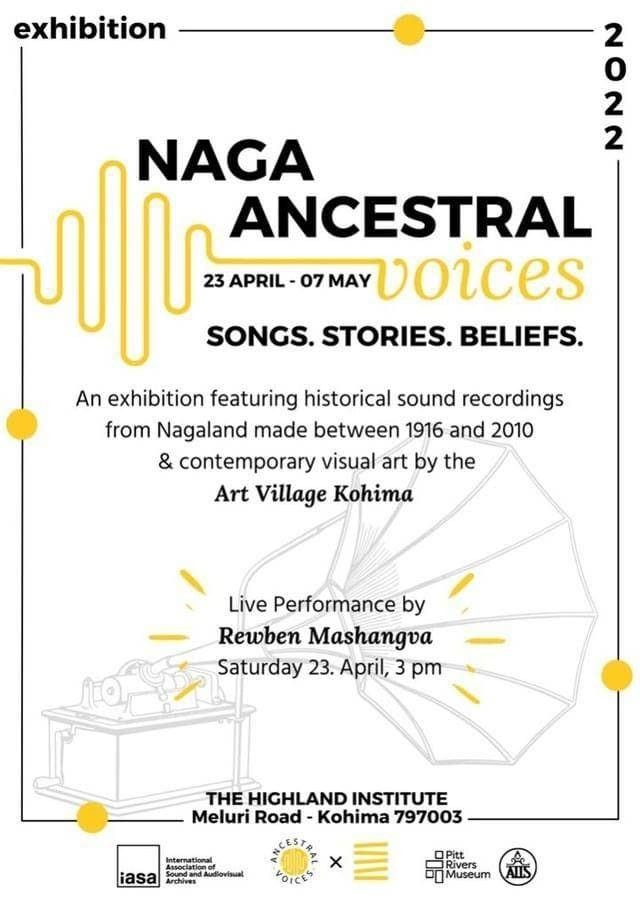
‘Naga Ancestral Voices’ exhibition in Kohima from April 23 to May 7
Kohima, April 22 (MExN): The Highland Institute, Kohima is organising an evocative exhibition opening in Kohima with the aim to ‘enable present-day Nagas to listen to the voices of their forebears from more than 100 years ago.’
Under the banner of the Naga Ancestral Voices, the exhibition will be held from April 23 to May 7. The exhibition will be launched on April 23 with a performance by Hao traditional music specialist Guru Rewben Mashangva, an introductory talk by Dr Christian Poske and an interview with artist Mhao Aaron.
The exhibition will take place at The Highland Institute, P Khel, Meluri Road, Kohima (Landmark: The Art Village). After the launch event on April 23, the exhibition will be open from 11:00 am to 4:00 pm Monday to Saturday until May 7.
Naga Ancestral Voices will be presenting song recordings from the Naga Hills made on wax cylinders by British administrator and anthropologist J. H. Hutton in the 1910s, speech samples from the Linguistic Survey of India from the 1920s, as well as more recent recordings by oral traditions scholar Thomas Kaiser from the 2000s.
According to the Highland Institute, Kohima, “this exhibition, the first of its kind in Nagaland, follows a research project that returned copies of Hutton’s recordings from the Pitt Rivers Museum (Oxford) to Nagaland.”
The Project lead, Dr Christian Poske said, “J. H. Hutton’s cylinders are probably the earliest sound recordings of Naga traditional music. Therefore, they hold immense cultural value for all Nagas. Our exhibition gives the people of Nagaland the unique opportunity to listen to Hutton’s recordings again after more than one hundred years and enables the Nagas to reconnect with this long-lost part of their intangible cultural heritage.”
Rhelo Kenye, Fellow of The Highland Institute and compere of the April 23 event, commented, “Critical engagement on the role of music as a creative cultural practice in understanding Naga society has been almost non-existent. In this context, an exhibition like this becomes crucial. It leads us to ask questions like: What is Naga in Naga Ancestral Voices? Can music become an important part of the larger field of Naga studies? Also, Naga Ancestral Voices should not exist in an isolated past but continue to shape meanings and perceptions of culture, identity, and society in the present.”
Visitors to Naga Ancestral Voices can not only hear a range of compelling recordings but also enjoy exciting contemporary complementary visual works by Mhao Aaron, The Art Village, Kohima, and multi-media artist Temsuyanger Longkumer.
Exciting educational workshops are available for schools on prior booking. Interested schools can contact: Lanu Aier + 91 70050 74609
Songs. Stories. Beliefs.
The sound recordings and artworks presented in this exhibition revolve around the theme of Naga traditional song and speech, which have served for centuries as a means for the Naga people to express their religious, cultural, and political identity. In the past one hundred years, the society, culture, and religion of Naga communities have undergone profound changes due to Christian Baptist proselytism and the influence of Western ways of life that British colonial rule and missionary work brought along. These changes reflect in the aural and visual exhibits displayed here, dating from the early 20th century to the early 21st century, bringing to life the voices of ancestors and contemporary communities.
Part of this exhibition outlines the outcomes of the research project ‘Recirculation of J. H. Hutton’s Recordings in Nagaland’, funded by the International Association of Sound and Audiovisual Archives (IASA) and conducted by Dr Christian Poske between January-March 2022, in collaboration with the Pitt Rivers Museum (Oxford), the Archives and Research Center for Ethnomusicology (Gurgaon), and the Highland Institute (Kohima). The project reconnected Naga communities with the early 20th century recordings of the British administrator and anthropologist John Henry Hutton (1885-1968), eliciting responses from listeners and gathering information on the content and context of the recordings.
Counterparts to Hutton’s cylinder recordings are Thomas Kaiser’s recordings from the early 21st century, which bear testimony to the continuity of Naga cultural identity and the changing political landscape of the wider Nagaland region. At the same time, Kaiser’s fieldwork exemplifies the changing attitudes towards Indigenous peoples in the post-colonial age, where ethnographers have endeavoured to represent Indigenous voices adequately and respectfully.
The Nagaland recordings of the Linguistic Survey of India, on the other hand, demonstrate how the British colonial administration supported conversion to the Christian faith in Nagaland and beyond through a linguistic research project, which required speakers to recite translations of bible parables in their mother tongues. Mhao Aaron Odyuo of the Art Village Kohima contributed two artworks to this exhibition that complement its aural aspects with powerful visual accents, an installation inspired by traditional Naga music culture and a painting inspired by the Linguistic Survey of India.
Finally, the exhibition dedicates a space to contemporary Naga music culture, characterised by its eclecticism that encompasses a range of styles. These include gospel songs, country music, pop, rock, heavy metal, rap, and Naga fusion music, which merge the musical heritage of Nagaland with modern arrangements, joining past and present.





